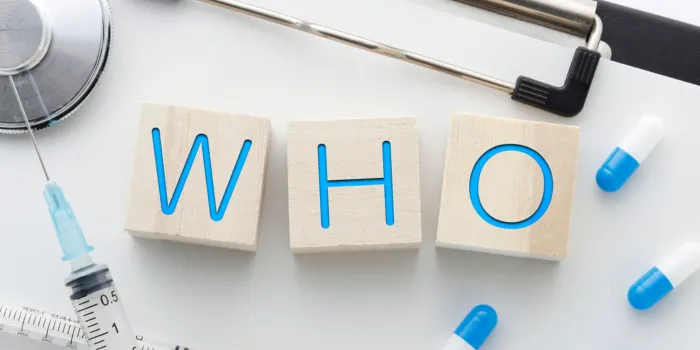A recent decision by the World Health Organization (WHO) is a critical milestone for people with hemophilia and von Willebrand disease (VWD) across the globe, experts say.
In September 2025, WHO updated its Essential Medicines List (EML) for adults and children to better reflect current international treatment guidelines for hemophilia and VWD. For the first time, the EML prioritizes safer and more effective treatments, while removing outdated and potentially harmful therapies.
“This is a huge victory for the global bleeding disorders community, and it’s one of the very few times when bleeding disorders have been included and prioritized in WHO guidance documents,” says Salome Mekhuzla, director of global development for the World Federation of Hemophilia (WFH), which spearheaded a two-year initiative to bring about these revisions.
Outdated Guidelines, Real Risks
The updates to the WHO’s EML are critically important to the global hemophilia community, says Glenn Pierce, M.D., Ph.D., vice president, medical for WFH. Before the updates, “WHO-EML was entrenched in 20th century recommendations for hemophilia, including recommending plasma products prepared in blood banks as the first line of treatment for persons with hemophilia,” Pierce says.
The old recommendations were a big problem for two reasons, according to Pierce. “First, in some lower income countries, HIV and hepatitis viruses are endemic, and many people are infected. That, coupled with blood screening testing that may not be at the level of rigor seen in the U.S., will result in transmission of deadly viruses by plasma derivatives.”
The second reason has to do with long-established best practices for the treatment of hemophilia. For more than thirty years, preventing bleeds has been recommended by major hemophilia physician and advocacy organizations, Pierce says. Prior to that, bleeds were treated on-demand, or after they have started.
“This means that blood accumulated at the site of the injury, such as a joint or muscle, and caused considerable damage and progressive destruction of the joint or muscle. In some cases, patients receiving on-demand treatment could have life-threatening bleeding,” Pierce says. “Prophylaxis to prevent bleeding is far superior and cannot be done with plasma products that need to be stored frozen in special refrigerators.”
A Closer Look at the EML Changes
These are the specific changes to the EML (for adults) and EMLc (for children), in relation to the medicines indicated for treatment of hemophilia and VWD:
New medicines added to the EML and EMLc
- The bi-specific monoclonal antibody emicizumab, a factor VIII mimetic, was included on the core list
- Recombinant FVIII and FIX clotting factor concentrates (CFCs) were included on the core list
Revisions made to existing medicines on the EML and EMLc
- Plasma-derived FVIII and FIX CFCs were transferred from the complementary list to the core list
- Desmopressin was transferred from the complementary list to the core list
Medicines or formulations deleted from the EML and EMLc
- Both pathogen-reduced and non-pathogen-reduced cryoprecipitate were removed as indications for the treatment of hemophilia and VWD
- Factor IX complex — also known as prothrombin complex concentrate (PCC) — was deleted as a therapeutic alternative to FIX CFCs
In its EML, WHO says, “the core list presents a list of minimum medicine needs for a basic health care system, listing the most efficacious, safe and cost–effective medicines for priority conditions.”
The complementary list, according to WHO, “presents essential medicines for priority diseases, for which specialized diagnostic or monitoring facilities, and/or specialist medical care, and/or specialist training are needed. In case of doubt, medicines may also be listed as complementary on the basis of consistent higher costs or less attractive cost-effectiveness in a variety of settings.”
Why the EML Matters
For rare diseases such as hemophilia, inclusion on the EML is a powerful advocacy tool that can drive improved access to treatment worldwide, Pierce says.
“WFH works with patient advocates, hemophilia treatment center advocates, and governments around the world to call for improved supply of clotting factors, FVIII mimetics, and now rebalancing agents to be used prophylactically to prevent bleeding,” he says. “This is a tough battle where governments don’t have the money to sustain health care needs for many acute and chronic illnesses, but putting clotting factor concentrates and a factor VIII mimetic on the essential medicines list helps countries justify decisions to purchase these agents for people with hemophilia.”
In addition, pharmaceutical companies often offer tiered pricing, access programs, or donations for drugs that are on WHO’s EML, which could make these medicines more accessible and affordable.
A Global Advocacy Effort
According to Mekhuzla, the EML updates would not have happened if it weren’t for the combined efforts of WFH’s partners in the U.S. and elsewhere around the world.
“We created a working group of subject matter experts, and we were in close dialogue throughout the two years with the WHO,” Mekhuzla says. The effort included hosting virtual and in-person meetings in Geneva, and mobilizing support from organizations, clinicians, and patient groups.
A letter of support addressed to the WHO director general was co-signed by 115 national member organizations of WFH and another joint letter was co-signed by 122 expert clinicians from all regions of the world. Other patient and professional organizations strengthened the advocacy efforts, with the National Bleeding Disorders Foundation (NBDF) and the Hemophilia Federation of America (HFA) issuing a joint statement raising concerns about WHO’s previous listing of cryoprecipitate and calling for the prioritization of safer alternatives.
“NBDF and the entire bleeding disorders community in the U.S. stood in support and solidarity of this cause,” Mekhuzla says.

